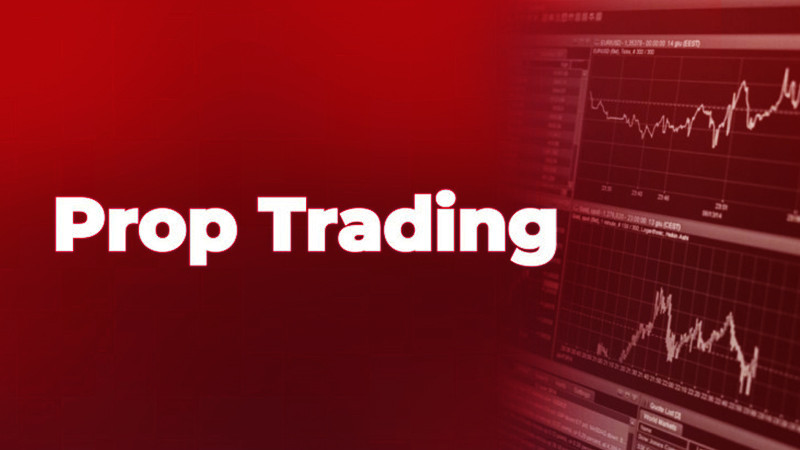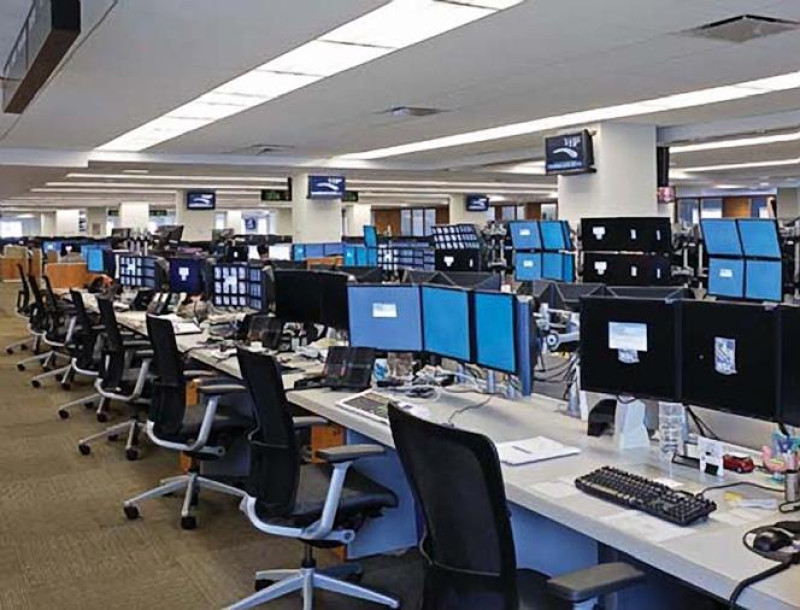
Over the past few decades, trading in the international markets has gained enormous popularity. Millions of traders around the world engage in various kinds of investing. Everyone aims to amass as much capital as possible to maximize the benefits from managing it. However, everyone starts from different backgrounds. Both beginners and mature investors are keen to learn about prop trading from personal experience.
This article explains what is trading using prop trading.
Some already have a sufficient level of savings that can be invested in a deposit to start earning. Others are tight in budget. Some have nothing but a strong desire to trade.
A solution for the latter group has been found as prop trading is based on the idea of zero commissions. The concept itself originated in the US and then spread into other languages, becoming one of the terms in the trading vocabulary.
Today, prop strategies are increasingly attracting attention and gaining popularity among fans.
How does prop trading work?
Proprietary trading, or private trading, originated in the US around the middle of the last century. It settled in other countries only a few decades ago. Therefore, it's considered relatively new but has already been recognized as a trading direction.
At its core, it's a mutually beneficial collaboration between retail traders and investors, who often act as either large or not-so-large companies.
In simple terms, prop trading is the opportunity to trade in financial markets of any kind using the company's funds. Profits generated from such operations are divided between the trader and the investor based on the agreed-upon terms.
In this scenario, the company provides free funds to be managed. However, sometimes a portion of personal money is required as collateral to ensure obligations.
In other words, prop trading represents a type of trading where the market participant uses not their own funds but those of an external company. A more strict definition would be as follows:
| Prop trading is a form of business based on investments that involves a company with surplus capital granting traders access to funds for management and earning in financial markets. |
An integral condition for trading with prop firms is the expertise of the trader. This is typically verified through the success of their own trading strategy.
The first prop firms emerged when retail investors lacked enough capital to make particularly large trades on the exchange. They decided to pool their efforts, i.e., merge their capital.
Later on, a developed infrastructure came into being, allowing direct access to trading platforms and the most advanced financial tools. Thus, the only thing left was to find savvy traders willing to earn. Only one thing was required from traders: to profit from the entrusted funds. A portion of this income was paid to the prop investor, and the trader kept the remaining share.
Commonly, companies charge a small percentage. This allows traders to earn well without their own initial capital. Investment firms need to ensure they reduce the risk of large capital losses. This is done by attracting as many traders as possible and testing their strategies.
Additionally, specialized software is developed. The staff includes so-called risk managers who monitor all opened and closed transactions.
The first prop firms started with trading entirely on exchanges. They added the forex market later. This is because there's no leverage on exchange platforms. Thus, the entrusted sum serves as its full replacement, making collaboration even more beneficial. Experienced traders without sufficient capital can trade in markets, make profits, and earn well.
The main advantage that prop trading has over working through a third party, for example, a brokerage firm, is the absence of conflicts of interest. This means that a capital drain benefits no one. The investor loses their funds. In turn, the trader stops earning and may lose the entrusted funds. Both sides are interested in making as many efficient trades as possible.Начало формы
What strategies to use in prop trading?
• The first option is choosing a strategy on one’s own. The trader can use their own strategy, which, in their opinion, is the most accurate and profitable.
• The second option is the firm's ready-made strategies. Investment firms often prepare and test trading strategies themselves, which they then share with their specialists. This further reduces the risks of potential losses and takes some responsibility off the traders.
Ways of cooperation in proprietary trading
| № | Option | Definition |
| 1. | Zero capital or minor investments by retail trader | Usually, potential employees are offered to pay for training which is mandatory before getting started trading in financial markets. The investor earns handsome returns, up to 50% from every transaction. Additionally, the investor is paid to buy special software. However, in total, the initial returns are still lower than when entering the market independently. |
| 2. | Large investments by retail trader | The investment company provides only a part of its own funds. A large share of investments is generated from the trader’s personal capital. The main percentage of profit remains with the employee, the firm takes only a small part - up to 10%. However, other commissions and additional fees may be included. This cooperation option is suitable for experienced traders with high risk appetites. |
| 3. | Combination of both types | The two previous types of cooperation may be combined. It implies significant initial investments with a guaranteed high percentage share in profits and losses. It is an egalitarian model. |
The practical side of prop trading shows that most often the company allows employees to trade only using strategies that can be strictly controlled. Intraday trading and scalping are most suitable for this.
The bottom line is that the fundamental principle on which any business, including investment, is built is to make a profit.
You should not confuse prop firms with other types of trust management. Their distinctive features include providing their own capital for management and a trading strategy tailored for efficient performance.

An important component is training. Typically, it's easier to train a good specialist from scratch than to retrain an employee who already has a trading background and an individual market vision.
How does prop firm operate?
The financial model of the prop business is quite simple. It focuses on investments. These investments are provided to external traders for their own profit, as well as for the company's earnings.
From this, it's clear that the main elements of this business are:
• Capital
• Commissions
• Specialized software
This list does not include the most important part: the traders. The entire success of the business depends on them. Thus, the firm begins its active operations only after an investor meets with a trader eager to trade.
The capital of prop firms consists exclusively of their own funds. They do not engage in attracting external investments. Typically, firms are formed by merging the capitals of several individuals possessing a certain amount of money. This combined sum will then be distributed among future employees as prop capital.
Personnel of prop company
| № | Staffer | Functions |
| 1. | Managing or chief traders | Most often, these are the company owners, i.e., the main investors, or either experienced traders responsible for coordinating activities. The number of people is 2-3. Their task is to make important decisions and bear responsibility for the activities. |
| 2. | Senior traders | They are employees with vast trading experience. Each has their own specialization: day trading, scalping, currency trading, etc. The number of people is up to 10. Their task is to train new employees, trade, and oversee trading. Each senior trader oversees a group of several medium-rank traders. |
| 3. | Prop traders as such | They are medium-rank employees who have undergone special training and testing, after which they were admitted to real work on the stock exchange. The number of people is variable. Their task is to trade and test trading strategies. |
| 4. | Junior traders (new-comers) | They are less experienced employees who have recently joined the company. They are still going through training and getting to know the company's established trading strategies. The number of people is variable. Their task is to learn, acquire trading skills, and trade. |
| 5. | Risk managers | These are employees responsible for monitoring the risks of trading practitioners. The number of people is variable. Their task is to monitor trading activities and prevent critical trading mistakes. |
| 6. | Analysts | These are employees whose duties include market monitoring and the collection of analytical data for trading traders. The number of people is variable. Their task is to collect and analyze information. |
| 7. | Trainers | These are employees responsible for training newcomers. The number of people is variable (typically, theoretical trainers are joined by practicing traders). Their task is to prepare new specialists to trade according to the company-developed strategies. |
| 8. | Technical support | These are employees specializing in the technical support to the company's activities. The number of people is variable. Their tasks are to develop software, write various types of software (indicators, trading robots, proprietary trading platforms, etc.), and troubleshoot technical issues. |
The backbone of a prop trading company is its traders. The firm is willing to invest time and money in their training and education. However, in return, they also expect effective trading that brings steady profits.
The lion's share of success in proprietary trading hinges exactly on medium-rank employees and seasoned traders. Typically, success is ensured by a few such team members.
This trading sector does not anticipate a high turnover of staff. The cases where employees switch from one company to another are quite rare.

As a rule, after getting trained, gaining practical experience, and earning their own capital, seasoned traders set out on their own, meaning they proceed to work solely with their own funds.
This becomes a significant problem for the business, as a lot of effort, time, and resources have to be spent on training new personnel. Interestingly, out of the vast number of applicants, only about 20% become highly efficient key players.
To save resources in some way, every investment firm devises its own unique employee selection system. Hiring anyone who applies is not the best strategy in this case.
What do prop trading firms require?
Although this sector is built on the principles of trust management of capital, it has its specifics. First and foremost, these relate to the amount of funds entrusted for management.
Commonly, at the initial stage of work, traders are provided with a modest sum, and strict limitations are set in their operations. This way, the company tries to avoid unnecessary losses.
Over time, the fund limit expands as the trader gains experience. Along with this, the trader's responsibility also increases.
The profit is also shared between the investor and the employee in specific proportions, as mentioned above.
You should get to know the detailed terms of employment directly from the chosen prop trading firm. Below are the most common restrictions encountered in prop trading.

Prop trading: key trading terms
- Firms mandatorily set an overall daily loss limit for an employee. Most often, these depend on the trader's experience and the trading strategy used.
- A requirement to deposit insurance capital serves as a guarantee commitment to the company. Experience shows that an employee's total losses cannot exceed this initial deposit.
- For the securities market, a particular limit is set on the total number of assets bought or sold. This limit lasts for a day.
- Restrictions are imposed on the maximum possible trading time. An employee's working day is strictly regulated, making it impossible to extend or end it earlier without management's consent.
- The chief manager can intervene in the trading process or even halt it at any moment. Significant reasons are required for this, especially if the account balance is approaching a critical point.
Like any business, proprietary trading has its advantages and disadvantages for both the trader and the investor. You can learn more about them below.
Particular aspects of prop trading for trader
| Pros | Cons |
|
|
|
|
|
|
|
|
| |
| |
| |
| |
|
Investors who are ready to provide their personal funds for management also have the opportunity to make good money and to end up with nothing.
Particular aspects of prop trading for investors
| Pros | Cons |
|
|
|
|
|
|
| |
| |
|
Becoming an employee of a prop trading firm with a solid reputation in the market is not easy. Sometimes, even experienced traders find themselves left out. This is because companies conduct rigorous candidate selection.
Typically, major investment firms hire only 4 to 6 new traders annually. Employers take into consideration not just the education but also the personal qualities of the candidate and even biographical data.
Preference is given to young individuals no older than thirty, without a family and children. This is because the would-be trader is expected to undergo an intensive training course lasting up to one and a half years.
Conclusion
Prop trading is an excellent option for trading in international markets for those willing to put in a lot of effort. These efforts are needed to hone trading skills and gain the utmost practical experience.
A trader without capital can get the opportunity to trade with the maximum benefit for himself. However, it's essential to remember that the investor company will always closely monitor every step of the employee. Only in this way can the risks of losses be minimized.
Prop trading can be an excellent start for a beginner in the field. Training and mentorship in the company will help you quickly grasp all the specifics of the profession and transition to a new level of work.
For seasoned traders, prop trading acts as a means of self-organization and more meticulous risk control.
You may also like:









 Back to articles
Back to articles

